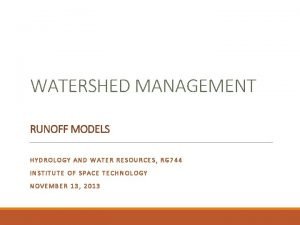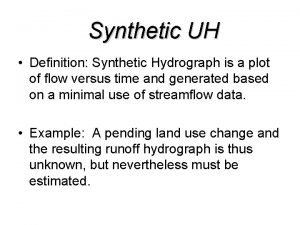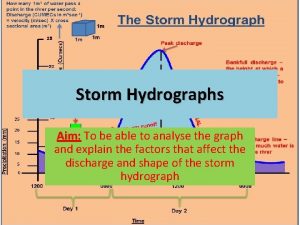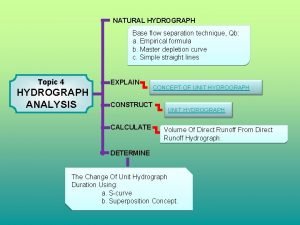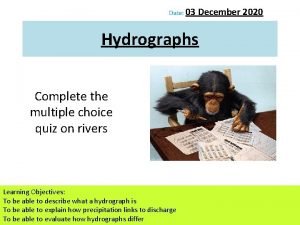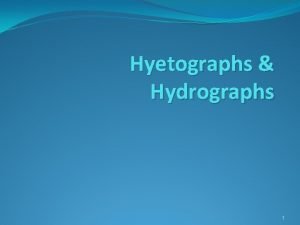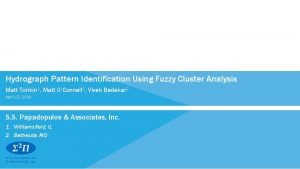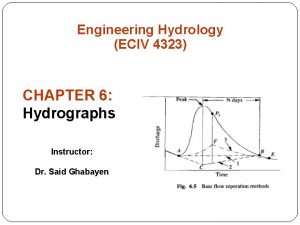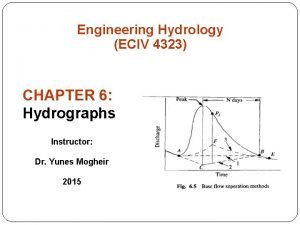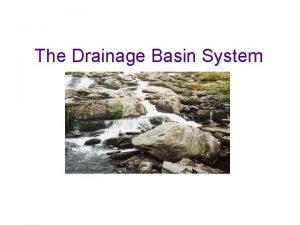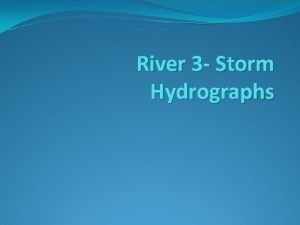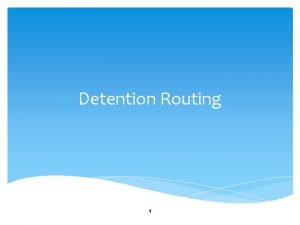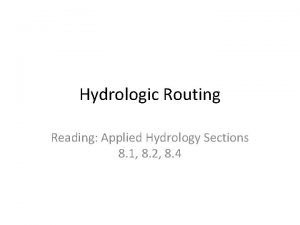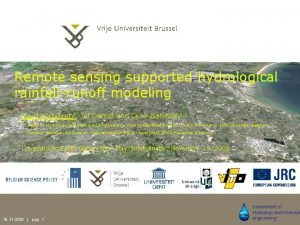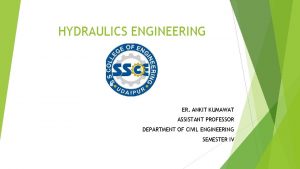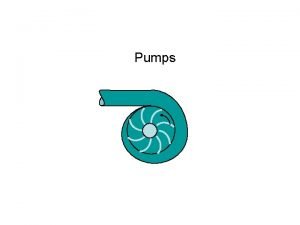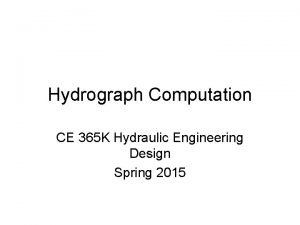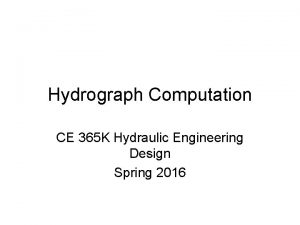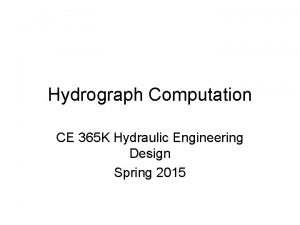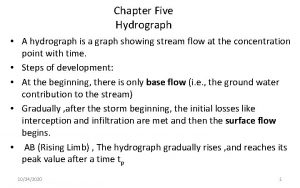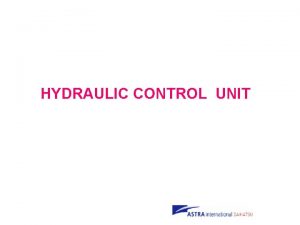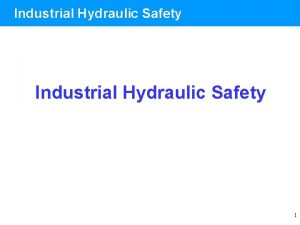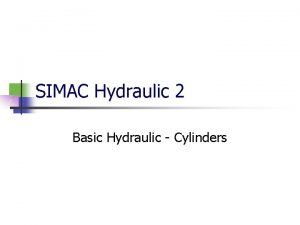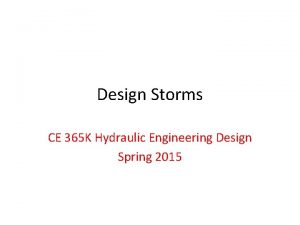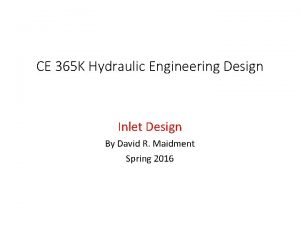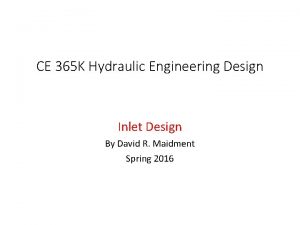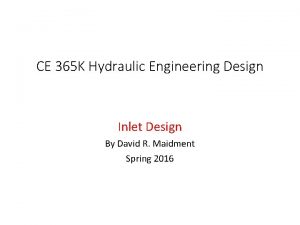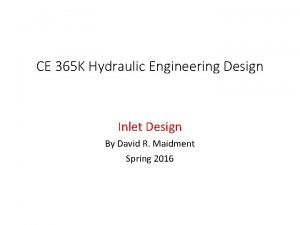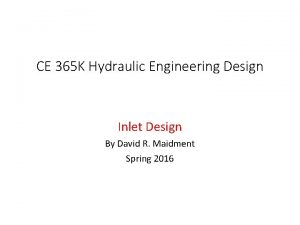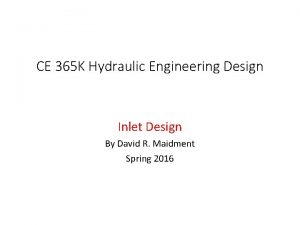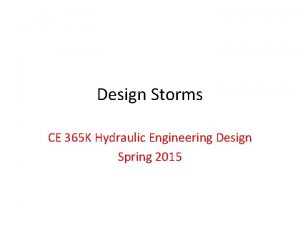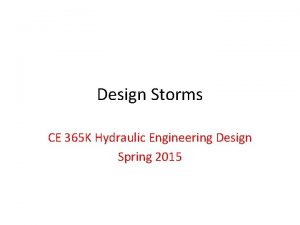Hydrograph Computation CE 365 K Hydraulic Engineering Design



















- Slides: 19

Hydrograph Computation CE 365 K Hydraulic Engineering Design Spring 2015

Depth-Duration-Frequency Table

Source: SCS TR-55 Manual, 1986

Source: SCS TR-55 Manual, 1986


Hydrologic Analysis Change in storage w. r. t. time = inflow - outflow In the case of a linear reservoir, S = k. Q Transfer function for a linear system (S = k. Q).

Proportionality and superposition • Linear system (k is constant in S = k. Q) – Proportionality • If I 1 Q 1 then C*I 2 C*Q 2 – Superposition • If I 1 Q 1 and I 2 Q 2, then I 1 +I 2 Q 1 + Q 2

Impulse response function Impulse input: an input applied instantaneously (spike) at time t and zero everywhere else An unit impulse at t produces as unit impulse response function u(t-t) Principle of proportionality and superposition

Unit Hydrograph Theory • Direct runoff hydrograph resulting from a unit depth of excess rainfall occurring uniformly on a watershed at a constant rate for a specified duration. • Unit pulse response function of a linear hydrologic system • Can be used to derive runoff from any excess rainfall on the watershed.

Unit hydrograph assumptions • Assumptions – Excess rainfall has constant intensity during duration – Excess rainfall is uniformly distributed on watershed – Base time of runoff is constant – Ordinates of unit hydrograph are proportional to total runoff (linearity) – Unit hydrograph represents all characteristics of watershed (lumped parameter) and is time invariant (stationarity)

Application of convolution to the output from a linear system

Need for synthetic UH • UH is applicable only for gauged watershed and for the point on the stream where data are measured • For other locations on the stream in the same watershed or for nearby (ungauged) watersheds, synthetic procedures are used.

SCS dimensionless hydrograph • Synthetic UH in which the discharge is expressed by the ratio of q to qp and time by the ratio of t to Tp • If peak discharge and lag time are known, UH can be estimated. Tc: time of concentration C = 2. 08 (483. 4 in English system) A: drainage area in km 2 (mi 2) tp = lag time in HEC-HMS

Example • Construct a 10 -min SCS UH. A = 3. 0 km 2 and Tc = 1. 25 h 0. 833 h q Multiply y-axis of SCS hydrograph by qp and x-axis by Tp to get the required UH, or construct a triangular UH 7. 49 m 3/s. cm 2. 22 h t

Watersheds upstream of Dam 6

Subbasin BUT_060

Flow along the longest path Channel Flow Shallow Flow Sheet Flow Sum travel times over each segment

Modeling Runoff from BUT_060 How to characterize this subbasin? How quickly does it move? How much runoff?

Results for Run “ 10” 24 hour design storm of 10” total precipitation in 10 min increments
 Runoff volume
Runoff volume Unit hydrograph
Unit hydrograph How to read a hydrograph
How to read a hydrograph Natural hydrograph
Natural hydrograph Flashy and flat hydrograph
Flashy and flat hydrograph Unit hydrograph convolution
Unit hydrograph convolution Storm hydrograph
Storm hydrograph Hydrograph analysis
Hydrograph analysis A hyetograph is a graphical representation of
A hyetograph is a graphical representation of Hair hydrograph
Hair hydrograph The basic assumptions of the unit hydrograph theory are
The basic assumptions of the unit hydrograph theory are The basic assumptions of the unit-hydrograph theory are
The basic assumptions of the unit-hydrograph theory are Passaic river hydrograph little falls
Passaic river hydrograph little falls Hydrograph
Hydrograph Storm hydrograph definition
Storm hydrograph definition Outflow hydrograph
Outflow hydrograph Hydrograph
Hydrograph Hydraulic engineering
Hydraulic engineering Ankit kumawat
Ankit kumawat Radial flow centrifugal pump
Radial flow centrifugal pump
